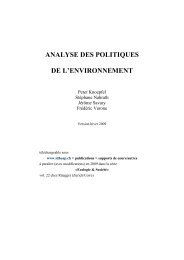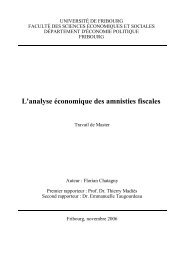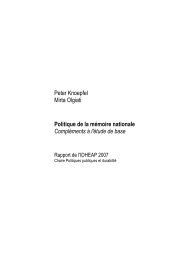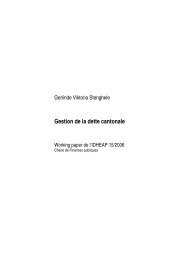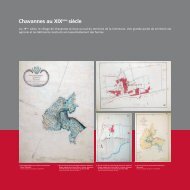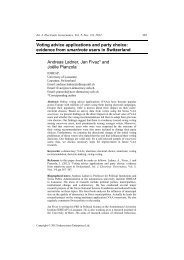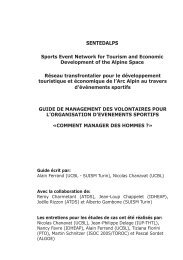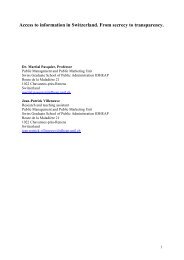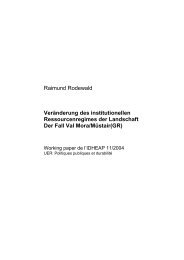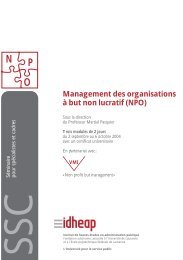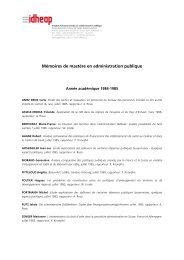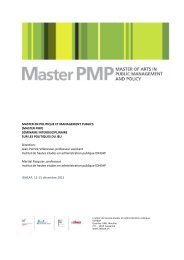Historical Analysis of Institutional Regimes in Switzerland ... - IDHEAP
Historical Analysis of Institutional Regimes in Switzerland ... - IDHEAP
Historical Analysis of Institutional Regimes in Switzerland ... - IDHEAP
Create successful ePaper yourself
Turn your PDF publications into a flip-book with our unique Google optimized e-Paper software.
13<br />
Degree <strong>of</strong><br />
Differentiation<br />
forest<br />
<strong>of</strong> the resourcespecific<br />
water<br />
policy design air soil<br />
landscape<br />
Degree <strong>of</strong> differentiation <strong>of</strong> the regulative system<br />
We would now like to discuss the exist<strong>in</strong>g IR types as well as the development trajectories for the<br />
five resources landscape, air, water, soil and forest <strong>in</strong> <strong>Switzerland</strong>. For each resource we shall<br />
discuss the goods and services provided by the resource, its property regulation, the policy design<br />
and regime type.<br />
a) Landscape (between a simple and complex regime)<br />
Goods and services: If natural resources are def<strong>in</strong>ed as valuable components <strong>of</strong> nature to be used to<br />
satisfy human needs over time, landscape can also be considered as a natural resource. However, <strong>in</strong><br />
comparison with other resources, <strong>in</strong> this <strong>in</strong>stance the resource stock is composed <strong>of</strong> several other<br />
resources, such as soil, forest, water etc. There is no consensus as to how landscape should be<br />
def<strong>in</strong>ed. Ecologists def<strong>in</strong>e landscape as “a complex <strong>of</strong> geographically, functionally and historically<br />
<strong>in</strong>terrelated ecosystems” (e.g. Do<strong>in</strong>g 1997), social scientists stress the function <strong>of</strong> liv<strong>in</strong>g space and the<br />
necessity <strong>of</strong> <strong>in</strong>dicators based on personal preferences. Landscape has been def<strong>in</strong>ed by the Swiss<br />
Environment Agency (SFA/SAEFL 1998: 19) as follows: “Landschaft umfasst den gesamten<br />
Raum, <strong>in</strong>nerhalb und ausserhalb von Siedlungen. Sie ist das Entstandene und Werdende<br />
natürlicher Faktoren wie Untergrund, Boden, Wasser, Luft, Licht, Klima, Fauna und Flora im<br />
Zusammenspiel mit kulturellen, gesellschaftlichen und wirtschaftlichen Faktoren.” 5 The<br />
harmonisation <strong>of</strong> the different exist<strong>in</strong>g def<strong>in</strong>itions is not only a demand<strong>in</strong>g scientific task, it is also<br />
crucial and necessary for the rais<strong>in</strong>g <strong>of</strong> public awareness and development <strong>of</strong> susta<strong>in</strong>able regimes.<br />
Whereas <strong>in</strong> the case <strong>of</strong> forests the flow - <strong>in</strong> terms <strong>of</strong> wood or protection - can easily be recognised,<br />
it is difficult to describe and quantify the resource units provided by a landscape. A tangible property<br />
is not given. Examples for the services provided by the resource landscape <strong>in</strong>clude biodiversity<br />
services, water regulation, aesthetic values, leisure amenities, cultural heritage etc. In many cases,<br />
therefore, it is a question <strong>of</strong> goods and services which are multiply l<strong>in</strong>ked with the perception <strong>of</strong><br />
consumers - the object is not really tangible.<br />
Property Rights: The historical analysis <strong>of</strong> landscape regimes shows that, with one exception, direct<br />
regulation <strong>of</strong> landscape only exists at the level <strong>of</strong> resource policy. Property and use rights have not<br />
been formulated through civil law.<br />
5 “Landscape <strong>in</strong>cludes all areas with<strong>in</strong> and outside settlements. It <strong>in</strong>cludes exist<strong>in</strong>g and future natural factors, e.g. subsoil, soil,<br />
water, air, light, climate, fauna and flora, <strong>in</strong> their <strong>in</strong>teraction with cultural, social and economic factors.”



